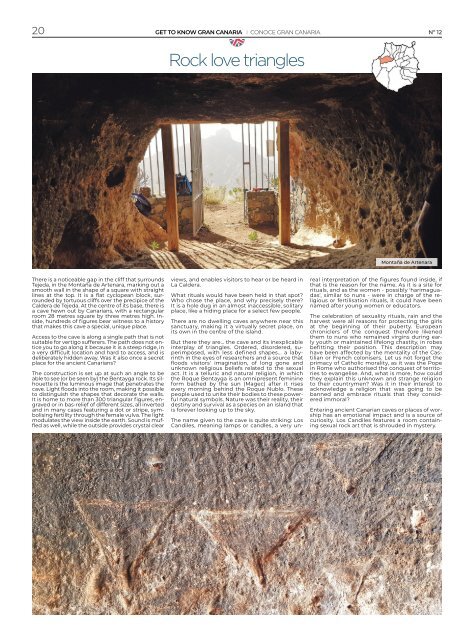No. 12 - Its Gran Canaria Magazine
Rutas, recomendaciones y noticias de Gran Canaria Routes, tips and news about Gran Canaria
Rutas, recomendaciones y noticias de Gran Canaria
Routes, tips and news about Gran Canaria
You also want an ePaper? Increase the reach of your titles
YUMPU automatically turns print PDFs into web optimized ePapers that Google loves.
20<br />
GET TO KNOW GRAN CANARIA I CONOCE GRAN CANARIA Nº <strong>12</strong><br />
Rock love triangles<br />
Montaña de Artenara<br />
There is a noticeable gap in the cliff that surrounds<br />
Tejeda, in the Montaña de Artenara, marking out a<br />
smooth wall in the shape of a square with straight<br />
lines at the top. It is a flat cyclopean block, surrounded<br />
by tortuous cliffs over the precipice of the<br />
Caldera de Tejeda. At the centre of its base, there is<br />
a cave hewn out by <strong>Canaria</strong>ns, with a rectangular<br />
room 28 metres square by three metres high. Inside,<br />
hundreds of figures bear witness to a history<br />
that makes this cave a special, unique place.<br />
Access to the cave is along a single path that is not<br />
suitable for vertigo sufferers. The path does not entice<br />
you to go along it because it is a steep ridge, in<br />
a very difficult location and hard to access, and is<br />
deliberately hidden away. Was it also once a secret<br />
place for the ancient <strong>Canaria</strong>ns?<br />
The construction is set up at such an angle to be<br />
able to see (or be seen by) the Bentayga rock. <strong>Its</strong> silhouette<br />
is the luminous image that penetrates the<br />
cave. Light floods into the room, making it possible<br />
to distinguish the shapes that decorate the walls.<br />
It is home to more than 300 triangular figures, engraved<br />
or in bas-relief of different sizes, all inverted<br />
and in many cases featuring a dot or stripe, symbolising<br />
fertility through the female vulva. The light<br />
modulates the view inside the earth. Sound is muffled<br />
as well, while the outside provides crystal clear<br />
views, and enables visitors to hear or be heard in<br />
La Caldera.<br />
What rituals would have been held in that spot?<br />
Who chose the place, and why precisely there?<br />
It is a hole dug in an almost inaccessible, solitary<br />
place, like a hiding place for a select few people.<br />
There are no dwelling caves anywhere near this<br />
sanctuary, making it a virtually secret place, on<br />
its own in the centre of the island.<br />
But there they are... the cave and its inexplicable<br />
interplay of triangles. Ordered, disordered, superimposed,<br />
with less defined shapes... a labyrinth<br />
in the eyes of researchers and a source that<br />
floods visitors' imagination, of long gone and<br />
unknown religious beliefs related to the sexual<br />
act. It is a telluric and natural religion, in which<br />
the Roque Bentayga is an omnipresent feminine<br />
form bathed by the sun (Magec) after it rises<br />
every morning behind the Roque Nublo. These<br />
people used to unite their bodies to these powerful<br />
natural symbols. Nature was their reality, their<br />
destiny and survival as a species on an island that<br />
is forever looking up to the sky.<br />
The name given to the cave is quite striking: Los<br />
Candiles, meaning lamps or candles, a very unreal<br />
interpretation of the figures found inside, if<br />
that is the reason for the name. As it is a site for<br />
rituals, and as the women - possibly 'harimaguadas',<br />
similar to nuns - were in charge of the religious<br />
or fertilisation rituals, it could have been<br />
named after young women or educators.<br />
The celebration of sexuality rituals, rain and the<br />
harvest were all reasons for protecting the girls<br />
at the beginning of their puberty. European<br />
chroniclers of the conquest therefore likened<br />
them to nuns who remained virgins during early<br />
youth or maintained lifelong chastity, in robes<br />
befitting their position. This description may<br />
have been affected by the mentality of the Castilian<br />
or French colonisers. Let us not forget the<br />
primacy of Catholic morality, as it was the Pope<br />
in Rome who authorised the conquest of territories<br />
to evangelise. And, what is more, how could<br />
they explain this unknown and strange religion<br />
to their countrymen? Was it in their interest to<br />
acknowledge a religion that was going to be<br />
banned and embrace rituals that they considered<br />
immoral?<br />
Entering ancient <strong>Canaria</strong>n caves or places of worship<br />
has an emotional impact and is a source of<br />
curiosity. Los Candiles features a room containing<br />
sexual rock art that is shrouded in mystery.

















